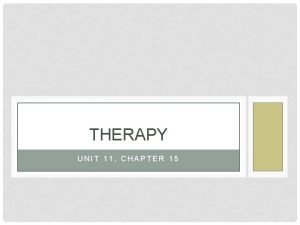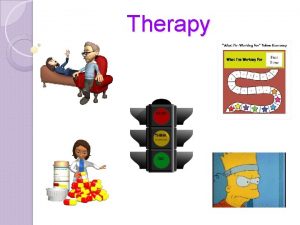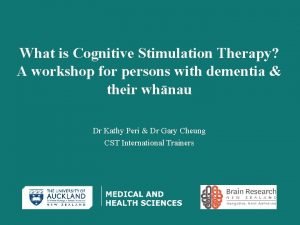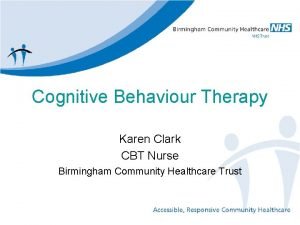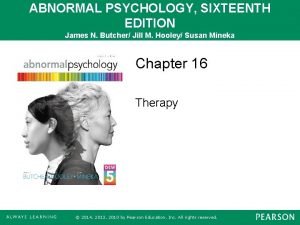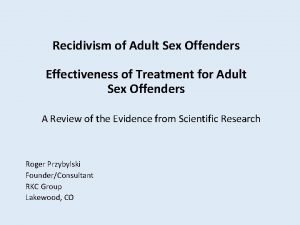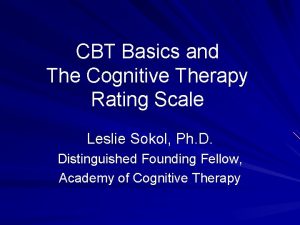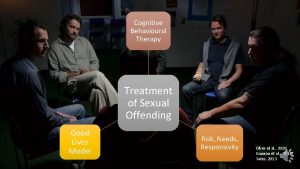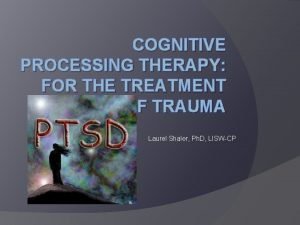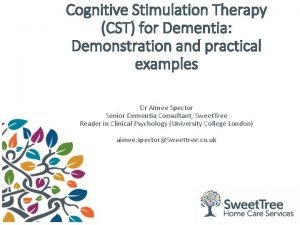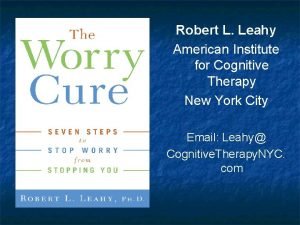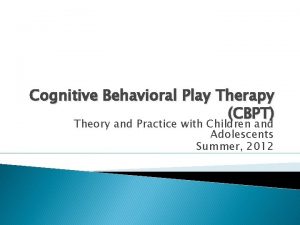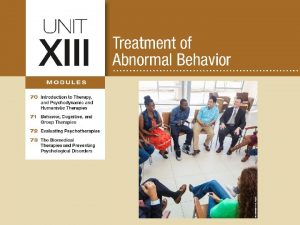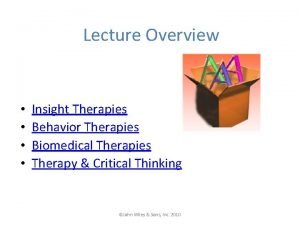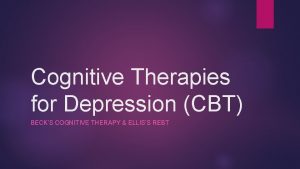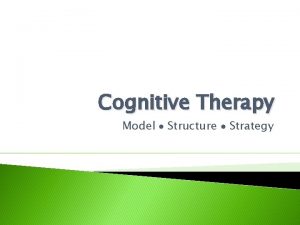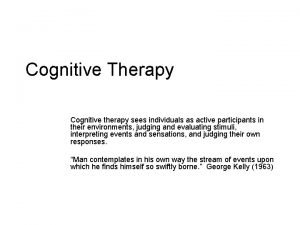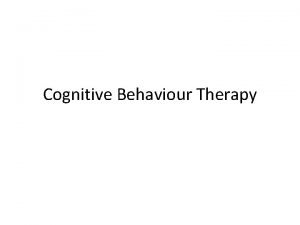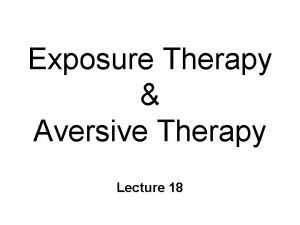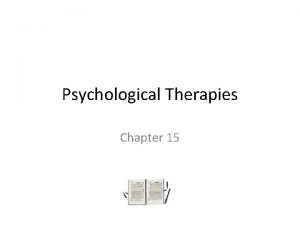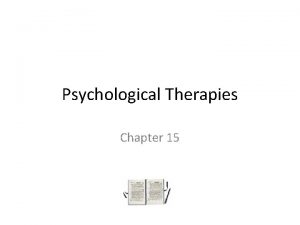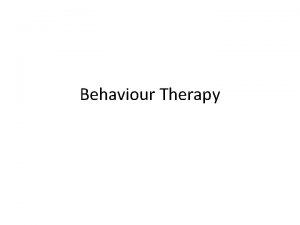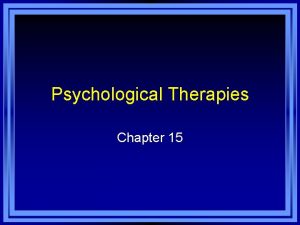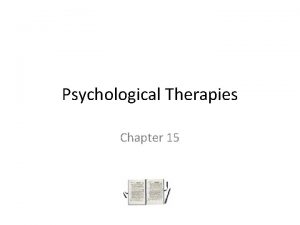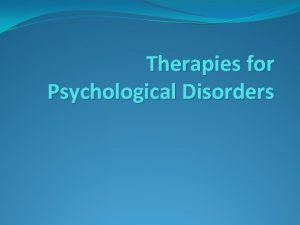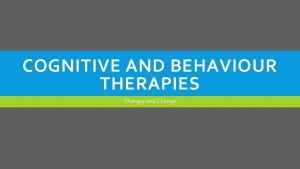Cognitive Therapies Module 71 Cognitive Therapy Assumes our























- Slides: 23

Cognitive Therapies Module 71

Cognitive Therapy • Assumes our thinking effects our feelings – Thoughts intervene between events and our emotional reactions – Depression often caused by self-blaming and overgeneralizing explanations of bad events • Therapy focuses on recognition and alteration of unhealthy thinking patterns – Teaches people new, more adaptive ways of thinking and acting

Self-Serving/Defeating Bias • Self-Serving Bias - Tendency to judge oneself favorably – Healthy people tend to do this • Self-Defeating Bias tendency to blame themselves for problems and credit the environment for successes • Severely depressed patients tend to do this

Rational Emotive Behavior Therapy • Developed by Albert Ellis • People’s difficulties are caused by their faulty expectations and irrational beliefs • Goal is to expose and confront the person’s core irrational beliefs • ABCDE model: § Activating Event § Disputing Irrational Beliefs § Beliefs - Irrational § Effective ways of § Consequences thinking & behaving developed • When an Activating event (A) occurs, it is the person’s Beliefs (B) about the event that cause emotional Consequences (C) • Effective in the treatment of depression, social phobia, and certain anxiety disorders, and in helping people overcome selfdefeating behaviors



How REBT Works • Step 1: Identify the core irrational beliefs or self talk that underlie personal distress • Step 2: Vigorously dispute and challenge the irrational beliefs. Therapist acts as a teacher to show patient how to do this. – Stop Irrational Thoughts – Reframe them to be more positive – Dispute irrational beliefs with evidence • Rational-emotive therapists tend to be very direct and even confrontational • From the client’s perspective, rational-emotive therapy requires considerable effort – person must admit her irrational beliefs and accept the fact that those beliefs are irrational and unhealthy – client must radically change her way of interpreting and responding to stressful events

REBT – AN EXAMPLE • PROBLEM: Social Phobic concerned they will be publicly embarrassed when giving a class presentation. • SOLUTION: Therapist questions the likelihood of such embarrassment occurring and impact of it. • Therapist’s goal is to show the client that not only is their failure unlikely, but even if it did happen, it would not be a big deal.

REBT Therapy

Aaron Beck’s Cognitive Therapy • Based on the assumption that thoughts, moods, and behaviors are interrelated • Beck believes that depression and other psychological problems are caused by distorted thinking and catastrophic beliefs • Focuses on changing the client’s unrealistic beliefs • Therapist acts as model and aims for a collaborative therapeutic climate • Therapy includes homework of writing down automatic thoughts or habits • Gentler, less combative approach than Albert Ellis’ REBT



Cognitive Therapy: How it Works • CT therapist encourages the client to empirically test the accuracy of his or her assumptions and beliefs – The client learns to recognize and monitor the automatic thoughts that occur without conscious effort or control – The client learns how to empirically test the reality of the automatic thoughts that are so upsetting • CT is very effective in treating depression, anxiety disorders, eating disorders, PTSD, and relationship problems. It may also help prevent depression from recurring

Ellis’ REBT vs. Beck’s Cognitive Therapy • REBT therapists logically debate • Beck stresses the quality of the and vigorously challenge or dispute therapeutic relationship the irrationality of a client’s beliefs. • Beck places more emphasis on the • Ellis views therapist as a teacher and does not think that a client discovering misconceptions warm personal relationship with a for themselves. client is essential. • The method is based upon the • REBT is often highly directive, particular disorder. persuasive and confrontive. • REBT uses different methods depending on the personality of the client


Cognitive Behavioral Therapy • An integrated therapy that combines cognitive therapy (changing self-defeating thinking) with behavior therapy (changing inappropriate behaviors) • Based on the assumption that cognitions, behaviors, and emotional responses are interrelated • Cognitive-behavioral therapists challenge maladaptive beliefs and substitute more adaptive cognitions • They use behavior modification, shaping, reinforcement, and modeling to teach problem solving and change unhealthy behavior patterns • Effective for treatment of anxiety, depression & anorexia nervosa

Prevalence of Cognitive Therapy Half of all faculty in accredited clinical psychology doctoral programs now align themselves with a cognitive or cognitivebehavior therapy orientation. (Data from Mayne & others, 1994. Note: Some faculty identify with more than one perspective. )

Family and Group Therapies

Group and Family Therapy • Group therapy—one or more therapists working with several people at the same time. • Family therapy—based on the assumption that the family is a system and treats the family as a unit. • Couple therapy—relationship therapy that helps with difficulty in marriage or other committed relationships

Group Therapy • Having a therapist work with a number of patients at one time • Groups usually consist of 6 to 10 people • Cognitive, behavior, and humanistic therapists all can lead group therapies.

Advantage of Group Therapy • Therapists can help more than one person at a time. • Overall session cost is lower. • Patients interact with others having the same problems as they have. • Builds a sense of community

Self-help groups: Helping yourself by helping others • Self-help groups and support groups are typically organized and led by nonprofessionals • The groups are either free or charge nominal fees to cover the cost of materials. • Typically, members have a common problem and meet for the purpose of exchanging support • The format of such groups varies enormously, but many follow a 12 -step approach • Self-help groups can be as effective as therapy • More research is needed on why self-help groups are effective and on the kinds of people and problems that are most likely to benefit from them

Family Therapy • Therapy that treats the family as a system • Views the patient’s problems as influenced by or directed at family members • Every family has certain unspoken “rules” of interaction and communication. • Issues are explored, and unhealthy patterns of family interaction can be identified and replaced with new “rules” that promote the psychological health of the family • Attempts to guide the family toward positive relationships and improved communication
 Systematic desensitization therapy
Systematic desensitization therapy Steps in systematic desensitization
Steps in systematic desensitization Module 73 the biomedical therapies
Module 73 the biomedical therapies Using job experiences for development assumes that
Using job experiences for development assumes that The due care theory assumes that the
The due care theory assumes that the Constructive alternativism
Constructive alternativism Mailspayment
Mailspayment The control process assumes that
The control process assumes that The going concern assumption assumes that the business
The going concern assumption assumes that the business Psychodynamic and humanistic therapies have in common
Psychodynamic and humanistic therapies have in common Bioness bits cost
Bioness bits cost Humanistic therapy aims to
Humanistic therapy aims to Cognitive stimulation therapy training
Cognitive stimulation therapy training Cbt history timeline
Cbt history timeline Cognitive therapy borrows many techniques from
Cognitive therapy borrows many techniques from Cognitive behavioral therapy for sex offenders
Cognitive behavioral therapy for sex offenders Cbt rating scale
Cbt rating scale Psychotherapy ap psychology definition
Psychotherapy ap psychology definition Cognitive behavioral therapy for sex offenders
Cognitive behavioral therapy for sex offenders A-b-c worksheet cpt
A-b-c worksheet cpt Cognitive stimulation therapy training course
Cognitive stimulation therapy training course American institute for cognitive therapy
American institute for cognitive therapy Cbpt training
Cbpt training Module 70 introduction to therapy
Module 70 introduction to therapy
